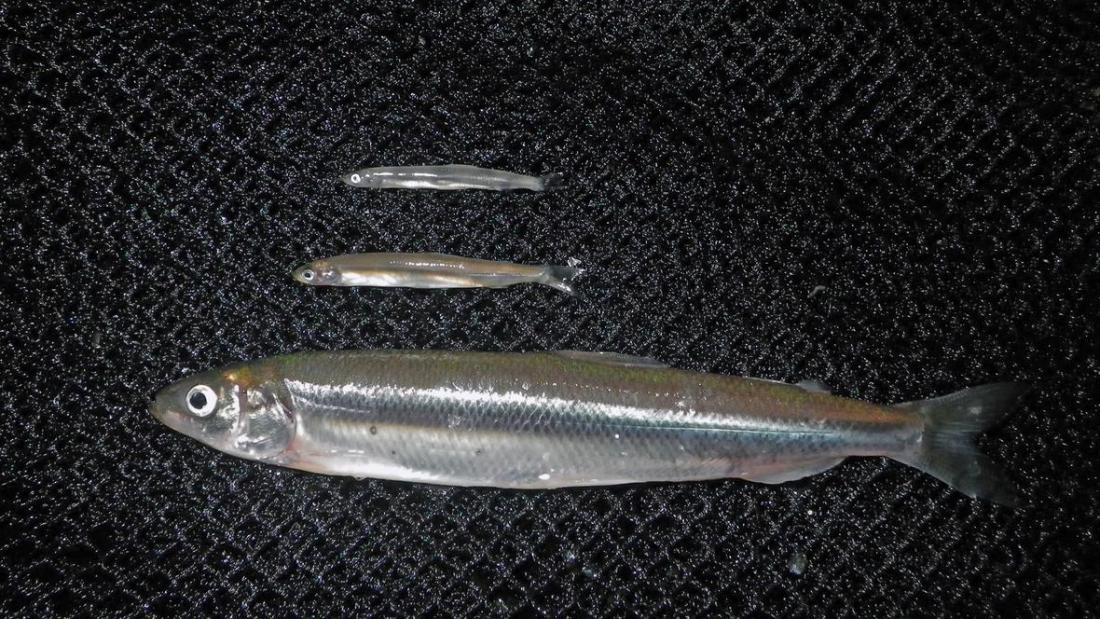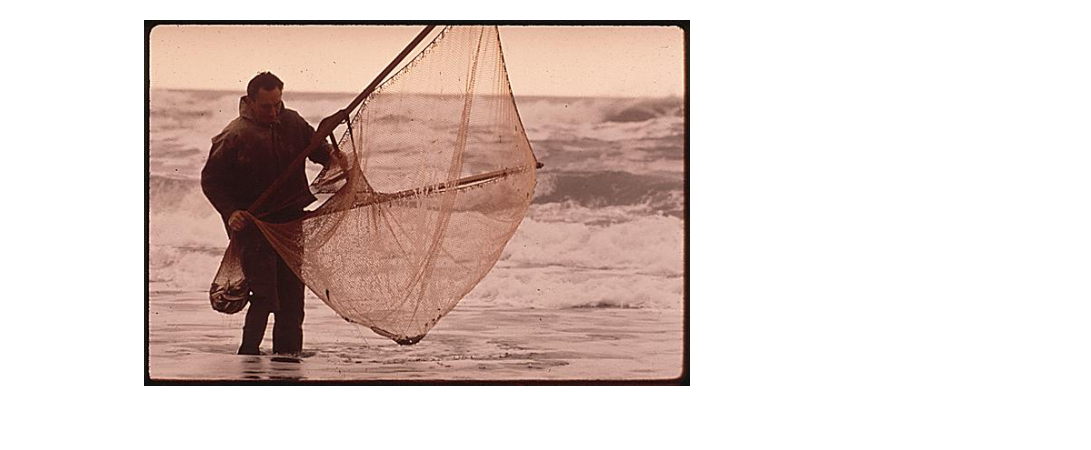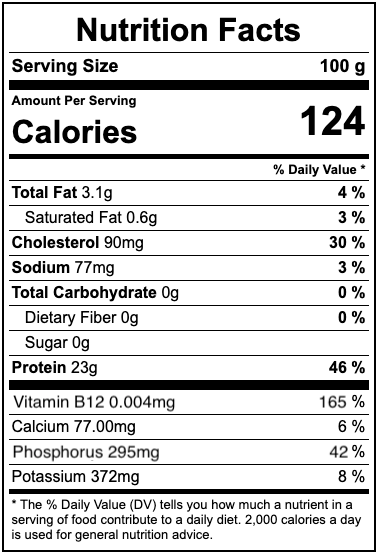Surf Smelt
Hypomesus pretiosus
The Science
THE SCIENCE
Love on the beach: Surf smelt spawn in schools on beaches during specific tidal cycles! [1]

Taxonomic description
- Surf smelt is a forage fish that can grow up to 12 inches, and is silver with a purplish hue and light green back. [1,2]
- Males can take on a golden hue during the mating season. [1,2]
- The key difference between night and surf (or day) smelt is with their mouths: surf smelt has a small mouth that don't go past its pupil, while night smelt (Spirinchus starksi) has a big mouth that goes past its pupil. [2]
Distribution
- Although its native range is throughout the coast of California, surf smelt is nowadays only seen in Northern California and further north all the way to Alaska. [1,2]
Life history
- Surf smelt can live up to 5 years, but specimens caught while spawning are usually 2 years old (males) and 3 years old (females). [1,2]
- Surf smelt spawn on the beach in large numbers. The male fish pursues the female and when he reaches her, they will bend together and vibrate to release eggs and sperm. The fertilized eggs will then be buried in the beach by waves. [1]
- Not much is known about this fish outside of its mating behavior, although it is known that the surf smelt eats planktonic organisms and in turn is food for many other marine animals. [1,3]
Habitat
- Because little is known about surf smelt outside of their spawning behavior, there are no confident estimates about where surf smelt live as juveniles and as adults in-between spawning seasons. It is presumed that this fish lives close to the shore as it is a common bycatch in the shrimp fishery. [3,4,5]
The Fishery
THE FISHERY
Surf smelt is still fished today using A-frame nets that have been used for centuries by Native American communities in Northern California. [4,5]

Seasonal availability
- In California most spawning is from June through September in the surf zone of beaches during high tides. [5]
- In Central California, peak months are from February to August. [15]
Regulatory and managing authority
- The California Department of Fish and Wildlife manages surf smelt fishing. [6]
- Recreational fishers can only take up to 25 pounds total of all smelt (including night smelt, day smelt, and whitebait smelt). [6]
- As this fish is found on the coast of several states, it is managed federally by the NOAA fisheries and the Pacific Fishery Management Council (PFMC) (as established by the Magnuson-Stevens Act) through the Coastal Pelagic Species Fishery Management Plan (FMP). [16]
- As established by the Marine Life Management Act, the California Fish and Game Commission regulates the fishery in state waters, and the California Department of Fish and Wildlife collects data and helps enforce FMP management rules for this fishery. [17,18]
Gear type
- Native Americans traditionally fished for smelt using A-frame dip nets, which are still used today. [5]
- Dip nets of any size and baited hoop nets smaller than 36 inches in diameter may be used in California. [6]
- Beach nets under 20 feet in length with meshes at least 7/8 of an inch in length can only be used north of Point Conception. [6]
- Cast nets and scoop nets are also used. [4]
Status of the fishery
- Very little is known about this fishery, but landings of surf smelt have been decreasing. [4,5]
Potential ecosystem impacts
- There is concern that recreational use of beaches may be crushing recently spawned eggs, and that alterations of inflowing streams or lagoons may also affect egg survival and spawning habitat. [5]
- Because most fish are caught during the critical spawning period, there is concern that overfishing is contributing to a decline in the population. [4]
- Decline of this fish may impact populations that prey on surf smelt, which includes endangered chinook salmon. [4]
The Seafood
THE SEAFOOD
As a very popular frying fish, smelt can be eaten whole! [7]


Edible portions
- This fish is usually eaten whole or without the head. Scales are usually not scraped off, and bones are not an issue, as the bones are softened by cooking. [7]
Description of meat
- Delicate and mild-tasting, and a little bit oily. The bones are soft enough to eat when cooked. [8]
Culinary uses
- Smelt is usually fried or grilled. [7]
- For a recipe for fried smelt fish, check out https://www.kawalingpinoy.com/crispy-fried-smelt-fish/. [9]
Nutritional information
- Smelt is a good source of protein, Omega-3 fatty acids, and contains many minerals and amino acids. [10]
- A table of general nutritional information about smelt cooked with dry heat based on rainbow smelt can be found on the right. [10]
Seasonal availability
- Wild-caught surf smelt is usually caught in California from June through September, but availability may vary. [5]
References
[1] Luna, S.M. Fish Base. n.d. Hypomesus pretiosus. Web. https://www.fishbase.de/summary/255. Accessed 2 July 2020.
[2] California Department of Fish and Wildlife. 2017. Creature Feature: Smelt. Web. https://cdfwmarine.wordpress.com/2017/01/19/creature-feature-smelt/. Accessed 2 July 2020.
[3] Port Gamble S'Klallam Tribe. n.d. Forage Fish. Web. https://www.pgst.nsn.us/content/pdfs/ForageFish.pdf. Accessed 2 July 2020.
[4] Seafood Watch Consulting Researcher. 2018. Surf Smelt. Web. https://www.seafoodwatch.org/-/m/be1aa1ad0ba54942ae5fa930c50cd564.pdf
[5] Sweetnam, D.A., Baxter R.D., & Moyle, P.B. California Department of Fish and Wildlife. 2001. California's Living Marine Resources: A Status Report. Web. https://nrm.dfg.ca.gov/FileHandler.ashx?DocumentID=34368&inline. Accessed 2 July 2020.
[6] California Department of Fish and Wildlife. 2020. California Recreational Ocean Fishing Regulations. Web. https://wildlife.ca.gov/Fishing/Ocean/Regulations/Sport-Fishing/General…. Accessed 2 July 2020.
[7] Carlson, J. Outdoor Life. 2016. Recipes for the Spring Smelt Run. Web. https://www.outdoorlife.com/blogs/cast-iron-chef/recipes-spring-smelt-r…. Accessed 3 July 2020.
[8] Shaw, H. The Spruce Eats. 2020. How to Cook Smelt. Web. https://www.thespruceeats.com/smelt-finger-food-extraordinaire-1300666. Accessed 3 July 2020.
[9] Manalo, L. Kawaling Pinoy. 2020. Crispy Fried Smelt Fish. Web. https://www.kawalingpinoy.com/crispy-fried-smelt-fish/. Accessed 3 July 2020.
[10] NutritionValue. 2020. Fish, dry heat, cooked, rainbow, smelt. Web. https://www.nutritionvalue.org/Fish%2C_dry_heat%2C_cooked%2C_rainbow%2C…. Accessed 3 July 2020.
[11] Ayers, D. USGS. 2012. Adult surf smelt collected in a beach seine by USGS Western Fisheries Research Center scientists while conducting a survey for juvenile surf smelt on Bainbridge Island, WA. Photo. https://www.usgs.gov/media/images/juvenile-surf-smelt-surveys-central-p…. Accessed 3 July 2020.
[12] Ayers, D. USGS. 2012. Three size classes of juvenile surf smelt collected in a beach seine by USGS Western Fisheries Research Center scientists while conducting a survey for juvenile surf smelt on Bainbridge Island, WA. Photo. https://www.usgs.gov/media/images/juvenile-surf-smelt-surveys-central-p…. Accessed 3 July 2020.
[13] Tomas, S. National Archives Catalog. 1972. Fishing for smelt on Gold Bluff Beach. Photo. https://catalog.archives.gov/id/543033. Accessed 3 July 2020.
[14] Iino, Koki. Getty Images. n.d. Dried Smelt. Photo. https://www.gettyimages.com/detail/photo/dried-smelt-royalty-free-image…. Accessed 3 July 2020.
[15] California Department of Fish and Wildlife. n.d. California Beach Fishing. Web. https://wildlife.ca.gov/fishing/ocean/beach-fishing. Accessed 17 July 2020.
[16] Coastal Pelagic Species Fishery Management Plan. 2019. Pacific Fishery Management Council. Web. https://www.pcouncil.org/documents/2019/06/cps-fmp-as-amended-through-a…. Accessed 24 August 2020.
[17] Marine Life Management Act. n.d. California Department of Fish and Wildlife. Web. https://wildlife.ca.gov/Conservation/Marine/MLMA. Accessed 24 August 2020.
[18] New and Proposed Regulations-2019. 2019. California Fish and Game Commission. Web. https://fgc.ca.gov/Regulations/2019-New-and-Proposed#180_6. Accessed 24 August 2020.



